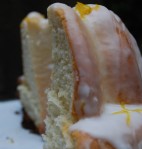I asked ‘Mr. Kaktus’ why he gave his shop its name. He replied: it is because we are spiky to our enemies, but soft and sweet inside to our customers.
By his enemies I assumed he meant his competitors, but in Swansea you never quite know. Other than Kaktus, the only other city centre Polish shop is Lolek, both are part of the wave of establishments set up by, and primarily for, the new wave of immigrants looking for a better working life in the UK. There are many good things in both shops and at their best the Polish products have a terrific quality and character that have not yet been totally dulled by the heavy hand of multi-national food giants.
My candidate for the gnomic ‘soft, sweet centre’ of Kaktus is masa makowa – poppy seed paste. Traditionally used at Polish Christmas to fill a crusty Swiss roll-type cake, I first came across it in a ‘first-generation’ Polish deli near where I lived in South London in the 80s. The shop had possibly been there since before the war and, when a tray of its home made cheesecake was in the window, you felt it was your lucky day – even if a slice ‘set you back an arm and a leg’. It was also the first time I’d came across the East European baked cheesecake and I found it very good, more complicated than the sometimes ‘electric’ flavours of the New World version. Where raisins are usually used, this Streatham High St. version of the Polish cheesecake offers its fruitiness in a dark layer of masa makowa.
The sweet, earthy flavoured lower stratum provides strong contrast to the pale, slightly sour baked curd cheese above; dryness and moisture, blandness and intensity, asceticism and indulgence, clarity and confusion, heaven and earth – whatever way you described such pairings, their balance is an important consideration in a dish like this – as it is of life.
Can food give a meaning to life? There is always good and interesting food out there to share. Relationships come and go, good fortune bobs up and down but somewhere around 25 years after coming across this cheesecake it was with a feeling of excitement, but with also something like inevitability, that I stumbled across a tin of the paste in Kaktus last year. Certainly there is one truth in the sharing of food, as a artist friend of ours simply states as only she can; you always have to make it with love.
Masa makowa is much more than crushed poppy seeds; it has a festive addition of dried fruits. Other than poppy seeds (22%) these are the more attractive ingredients listed on the tin; poppy seeds, sugar, dried fruits and orange peel (what artificial honey is I don’t know, and probably never wish to). In Mary Pininska’s The Polish Kitchen (Grub Street, London, 2008) I have since found a recipe for the paste that also includes butter, ‘real’ honey, vanilla, eggs and brandy. The recipe confirms my hunch that poppy seeds are as hard as rocks (the initial preparation before grinding involves two soaking sessions in boiling water followed by one in milk, ); so for now I’m glad to have access to the tinned paste, complete with its ‘artificial honey’. However I’ll store my second tin upside down to redistribute the citrus syrup that I found out too late had settled to the bottom. It would be a sort of heresy to suggest that the poppy seed paste is in some way better than the British Christmas mincemeat, but given the opportunity I would fill some seasonal mince pies with it and let people tuck in without prejudice or preconceptions.
This time I followed Mary Pininska’s Polish cheesecake recipe but it was universally deemed not so flavoursome as the previous recipe I that I had tried from Lesley Chamberlain’s Russian, Polish and German Cooking (Hermes House, 2004) that has addition of soured cream and some vanilla essence to the dairy layer. (ROR – Recipe on Request!)
I baked it in a springform mould with only a pasty base. This is a image of the emerged, and intact, result – as the full quote goes I would know my shadow and my light, for then I shall be whole. – even if, in this case, it passed too long near the flames of that inferno known as gas mark 4.
(I could mention so many good things that discovered from browsing in Kaktus, let alone Lolek: varied, high quality charcuterie; commercially produced, but delicately flavoured, soft cheese; preserved sorrel; terrific gherkins and, occasionally, delicately preserved Russian tomatoes and earthy chocolate – yes, I agree, that’s all for another post.)













